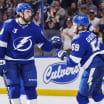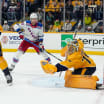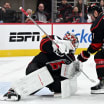Here is the Dec. 18 edition of the weekly NHL.com mailbag, where we answer your questions asked on X and Bluesky. Send your questions to @drosennhl and @NHLdotcom on X, or @drosennhl.bsky.social on Bluesky, and tag them with #OvertheBoards.
Mailbag: Rangers’ issues on defense; players must fix Sabres skid
NHL.com's Dan Rosen answers weekly questions

© Bill Wippert/NHLI via Getty Images
Should the New York Rangers focus on solidifying their defense over adding forwards? Basically, do you think they would have a better chance to keep the season alive by building from their strength in goal out with the trade market and then use free agency to revamp the forward group? -- @koko_costanza
The answer to your question is a resounding yes. That should be the focus now and in the offseason.
The Rangers’ strength is in goal with Igor Shesterkin locked up for eight more seasons after this one at $11.5 million per. As good as Shesterkin is, any Stanley Cup contending team needs a strong defense group to insulate the goalie, making sure he has help to do his job and maybe on rare occasions steal a game. Think of the goalies who have won the Stanley Cup recently and what do they all have in common? Their team’s play in front of them was sensational. Tim Thomas won the Conn Smythe Trophy with the Boston Bruins in 2011 and Jonathan Quick did so with the Los Angeles Kings in 2012. Since then, one goalie has been voted as the most valuable player in the Stanley Cup Playoffs; Andrei Vasilevskiy with the Tampa Bay Lightning in 2021. It’s about defense. It’s always about defense. And in the NHL today, it’s about a big, mobile defense group. Look at the Vegas Golden Knights. Look at the Florida Panthers. Size matters. Quickness matters. The Rangers need to build a bigger, quicker, better back end.
Trading Jacob Trouba was not the answer for this season. That didn’t solve anything in the short term. But in the long term, it’s the right move. It saves them $8 million on the salary cap through next season. Trouba can still play and he has size, but he’s not as mobile as he once was. He’s more of a third-pair defenseman on a contending team at this point. The Rangers can’t pay $8 million to a third-pair defenseman. They need to get quicker on the back end.
For the same reason is why Ryan Lindgren is likely in his last season in New York. He’s been a warrior, but Lindgren has a lot of miles, bumps and bruises on him. He’s not mobile. He’s not quick. Adam Fox needs a defense partner that can be a safety net for him, which Lindgren has been for years. But Fox needs a defense partner with some more life in his legs than Lindgren has left. K'Andre Miller entices you with his skating and his size (6-foot-5, 210 pounds). He should be the ideal partner for Fox. But if he’s going to stay in New York, and that’s not a given seeing that he’s a pending restricted free agent, Miller needs to work on getting the puck off his stick quicker and using his size to be a more physical presence to clear the front of the net and win battles behind it. That’s not Fox’s job.
Braden Schneider may be best suited as a third-pair, right-shot defenseman, but he’s got mobility, size (6-foot-4, 213 pounds) and a physical style. He can play 16-18 quality minutes on a contending team. We’ve seen it. Victor Mancini is raw, but he too has the mobility, size (6-3, 229), puck-handling skills and first-pass ability that could make him a part of New York’s future blue line. The issue is both Mancini and Schneider are righties. If you want balance, one will have to play on the second pair. That’s fine if the Rangers add an impact left-shot defenseman. Zac Jones is a lefty, but he hasn’t flourished with more ice time. If he’s on the third pair you can live with it, but my preference would be to have more size. Jones is 5-11, 190.
How the Rangers can turn their season around
Is Terry Pegula the problem? Is Kevyn Adams the problem? What say in the League circles? -- @RyanPuckhaber
Pegula, the Buffalo Sabres owner, is not the problem or the reason why the team is struggling and looking toward its 14th consecutive season without making the playoffs. Adams, the Sabres general manager, is not the problem. He has put together a team that should be better than it is, a team that should never lose 10 games in a row (0-7-3) as it had entering Tuesday. The talent is in the room. They have quality goaltending. The coach, Lindy Ruff, is not the problem. He has installed an up-tempo style of play that the players should be able to adopt and enjoy because it allows their skillsets to shine as long as they do the non-negotiables: bring a positive attitude, give effort, commit to playing defense, checking hard and forechecking, and hold each other accountable. But that’s not happening enough, so the players have to take ownership for what’s going on in Buffalo. The fix starts with them, with understanding talent alone isn’t enough to win in this league. You need to play under duress. You need to manage success and not let it get to your head. You need to simplify when things aren’t going your way. The Sabres struggle when they’re pressured, lose too often when they score the first goal (7-8-4 entering Tuesday) or when they have a lead after the first period (7-4-4 entering Tuesday). They make things harder on themselves. How is any of that on the owner, GM or coach?
The Sabres have a young roster (average age 26 years old), but they don’t have inexperienced players. Bowen Byram, Owen Power, Mattias Samuelsson and JJ Peterka are approaching 200 games played in the NHL. It’s time for all of them to take the next step. Dylan Cozens, Henri Jokiharju, Connor Clifton and Sam Lafferty have played more than 300. Tage Thompson is one away from 400. Jordan Greenway, Rasmus Dahlin and Alex Tuch have each played in more than 400. Tuch is approaching 500. All of them should be in their prime now. They have played a lot of games together, so chemistry shouldn’t be a problem.
You could almost understand the dropoff in the 2021-22 season when the Sabres went 3-13-4 from Nov. 18-Jan. 11, effectively ruining their season. They were younger, just trying to put something together. It was less understandable the following season, when they lost eight games in a row, all in regulation, in November. But at least you could say they were a work in progress. They finished that season with 42 wins and missed the playoffs by one point. They did not build off of it last season, hence the coaching change from Don Granato to Ruff. But Buffalo added in the offseason, players like Lafferty, Jason Zucker, Beck Malenstyn and Ryan McLeod fresh off of playing in the Stanley Cup Final with the Edmonton Oilers. Jack Quinn and Samuelsson were back from injury. Ukko-Pekka Luukkonen was an established No. 1 goalie.
There’s no excuse anymore for a 10-game stretch like this. The players have to be better.
John Gibson or Karel Vejmelka, who should be traded first and why? -- @angileaf.bsky.social
It should be Gibson from the Anaheim Ducks ahead of Vejmelka from the Utah Hockey Club, even though Vejmelka is in the last year of a three-year contract and Gibson has this season plus two more remaining on his eight-year contract. Vejmelka can become an unrestricted free agent after the season, but Utah isn’t in a position to trade a good asset at this point. Utah has playoff aspirations this season and Vejmelka has been its best goalie with a 2.40 goals-against average and .915 save percentage in 17 games (15 starts). Utah is riding Vejmelka now and he’s playing well. It will have to ride him more to be a playoff team, which really is the goal for the NHL’s newest team. It would be big in many ways, including financially and fan interest-wise, if Utah can make the jump to be a playoff team in its first season. Vejmelka is 28 years old, and re-signing him could become a priority if he continues to play well.
Gibson is different. The Ducks are not in a position to be a playoff team this season and they should be looking to get assets for Gibson when he still has value as a No. 1 goalie with cost certainty to a team. A lot of teams would or should be in the market for Gibson, including the Carolina Hurricanes, Detroit Red Wings, Philadelphia Flyers, Los Angeles Kings and Calgary Flames. There’s a market for him and the Ducks would likely get more for Gibson than Utah would get for Vejmelka.
VGK@ANA: Gibson robs Eichel with a remarkable save in 3rd
When will Barry Trotz admit that signing a bunch of guys age 30 and up wasn’t a great idea? -- @amazingjr87.bsky.social
The answer is he won’t, and it doesn’t matter anyway. The Nashville Predators have to make this work with Steven Stamkos, Jonathan Marchessault and Brady Skjei. Stamkos signed for four years ($8 million AAV), Marchessault for five ($5.5 million AAV) and Skjei for seven ($7 million AAV). They’re in the mix. They’re staying. So now the Predators and Trotz, their general manager, have to figure it out with them. There’s absolutely no reason why they can’t become a good team. There is absolutely no reason why they should have the worst offense in the NHL. The pieces haven’t fit yet. That doesn’t mean they can’t or won’t. It’s easy to take the stance that a coaching change will solve their problems. Maybe it would. Maybe they too would experience the coaching shakeup bump the way the Boston Bruins and St. Louis Blues have. But in the end, it will make Andrew Brunette the scapegoat. Trotz, as a longtime coach in this league, knows exactly what Brunette is going through and likely will have patience. Chemistry is a real thing. The Predators clearly don’t have it together yet. But Stamkos, Marchessault and Skjei are not going anywhere, so don’t expect Trotz to admit defeat or any wrongdoing.
Will the NHL follow the NBA’s lead of holding an in-season tournament? -- @NYCKING
The NHL is having an in-season tournament, albeit in a different fashion from the NBA. That’s what the upcoming 4 Nations Face-Off is going to be, and what future World Cup tournaments are going to be ideally starting in 2028 and going every four years, with Olympic participation expected to be a part of the international schedule to starting in 2026. Players want best-on-best international competition. The NHL regular season is already strong with great parity. Things are ever-changing, obviously, but right now the international competition is intended to provide an in-season spark, a changeup if you will. Considering how much players care about representing their countries, the expectation is for the 4 Nations Face-Off and future World Cup tournaments to be elite, compelling hockey.



















